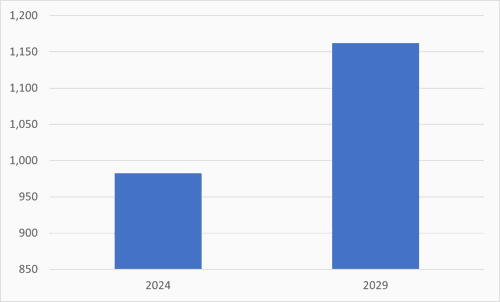Is It Time for Digital Travel Credentials to Take Off?
International travel is a massive industry; over 800 million people travelled internationally in 2023, according to Juniper Research data. Over half (53.2%) travel by air, with land travel being the second most common mode (43%). The number of travellers will continue to grow, driven by the growth of international tourism and business trips in high-growth developing markets, especially China.
Global Number of People Travelling Internationally (m), 2024 vs. 2029

Source: Juniper Research
As in all other industries, international travellers are increasingly demanding a more streamlined and digital service. Air travel in particular is notorious for its slow check-in process, although identity checks at any border can be time-consuming. It is this friction that is driving the move towards DTCs (Digital Travel Credentials).
There are three categories of DTCs:
- Type 1: Type 1 DTCs are eMRTDs (Machine Readable Travel Documents) that are generated by reading the physical travel credential’s chip, with either a smartphone or a self-service kiosk. For Type 1 DTCs, the user must still carry the physical document, with the eMRTD acting as a form of authentication.
- Type 2: Type 2 DTCs are issued by the same authority as a physical passport, signed by the authority, and linked to the physical passport. The DTC is linked to physical devices and can be used independently of the physical document, which acts as a backup to the DTC. It is important to note that the DTC is based on a physical document, which must still be issued first.
- Type 3: Type 3 DTCs are issued and signed by the issuing authority, and stored on devices. The DTC is not linked to a physical component, which means it can be issued to an individual who does not have a physical passport.
These three different varieties of DTCs offer a progression of how DTCs can be introduced, with the need for physical travel credentials phased out over the three types. This is important, as many governments do not want to abandon physical passports at this point in time. This can be largely attributed to security concerns, with the established system being trusted by authorities. In many markets, a section of the population is either opposed to the principle to digital identity documents of any kind, or not technologically proficient. It is important that governments maintain services to these groups, necessitating the maintenance of physical passport services.
As things stand, no country has fully implemented DTCs, although several pilot schemes have been carried out. This includes a trial which ran between August 2023 and March 2024 in Finland, and another carried out from the 29th February to the 31st of March 2024 in the Netherlands. These pilots were considered successful, with the Finnish pilot carrying out 355 successful DTC checks, with the average check taking eight seconds. The pilots, which both used Type 1 DTCs, were used to inform the EU’s regulation of border checks with DTCs.
The positive results of these pilots indicates that the EU will be introducing regulation to allow the implementation of Type 1 DTCs. These will be combined with automated facial recognition technology, to allow DTC users to progress more quickly through airport check-in. These DTCs will be focused on air travel, as passports are not needed to travel through the Schengen Area, and international travel across sea borders is rarer and generally poses less friction.
In the future, DTCs within the EU will be able to be held within a European Identity Wallet, as set out in the eIDAS2 regulation; this will be the ideal place to store a Type 2 or Type 3 DTC. Based on this knowledge, Juniper Research expects the EU to lead the way in the adoption of DTCs over the medium term.
Outside of the EU, there is less concrete movement towards Type 1 DTCs. However, the ICAO (International Civil Aviation Organisation) has been active in promoting standards, defining the categories of Type 1, 2 and 3 DTCs. This work will make it easier for countries to adopt DTCs, as the credentials will operate on the same standards at both ends of the journey. Countries looking to implement DTCs must ensure that they offer a smoother customer experience than the current system provides, to ensure consumer adoption.
Michael is a Senior Research Analyst at Juniper Research, and primarily conducts research on digital identity and payments markets. His recent reports include Digital Identity, Instant Payments, and B2B Payments.
Latest research, whitepapers & press releases
-
 ReportDecember 2025
ReportDecember 2025AI Agents for Customer Experience Platforms Market: 2025-2030
Our comprehensive AI Agents for Customer Experience Platforms research suite comprises detailed assessment of a market that is set to disrupt mobile communications. It provides stakeholders with insight into the key opportunities within the AI agents for customer experience platforms market over the next two years.
VIEW -
 ReportDecember 2025Fintech & Payments
ReportDecember 2025Fintech & PaymentseCommerce Fraud Prevention Market: 2025-2030
Our eCommerce Fraud Prevention research suite provides a detailed and insightful analysis of this evolving market; enabling stakeholders from financial institutions, law enforcement agencies, regulatory bodies and technology vendors to understand future growth, key trends, and the competitive environment.
VIEW -
 ReportNovember 2025Telecoms & Connectivity
ReportNovember 2025Telecoms & ConnectivityeSIMs & iSIMs Market: 2025-2030
Juniper Research’s eSIMs and iSIMs research suite offers insightful analysis of a market set to experience significant growth in the next five years. The research suite provides mobile network operators (MNOs), original equipment manufacturers (OEMs), and eSIM management and platforms vendors with intelligence on how to capitalise on the market growth, and guidance on how eSIM-only devices and sensors, SGP.42, in-factory provisioning, and iSIMs will change the competitive landscape.
VIEW -
 ReportNovember 2025Fintech & Payments
ReportNovember 2025Fintech & PaymentsModern Card Issuing Platforms Market: 2025-2030
Our Modern Card Issuing Platforms Market research suite provides a detailed and insightful analysis of this evolving market; enabling stakeholders from banks, financial institutions, fintech companies, and technology vendors to understand future growth, key trends, and the competitive environment.
VIEW -
 ReportNovember 2025Fintech & Payments
ReportNovember 2025Fintech & PaymentsDigital Wallets Market: 2025-2030
Our digital wallets research suite provides detailed analysis of this rapidly changing market; allowing digital wallet providers to gain an understanding of key payment trends and challenges, potential growth opportunities, and the competitive environment.
VIEW -
 ReportOctober 2025Fintech & Payments
ReportOctober 2025Fintech & PaymentsDigital Identity Market: 2025-2030
Juniper Research’s Digital Identity research suite provides a comprehensive and insightful analysis of this market; enabling stakeholders, including digital identity platform providers, digital identity verification providers, government agencies, banks, and many others, to understand future growth, key trends, and the competitive environment.
VIEW
-
 WhitepaperDecember 2025Telecoms & Connectivity
WhitepaperDecember 2025Telecoms & ConnectivityHuman + AI: Drivers of Customer Experience AI Agents in 2026
Our complimentary whitepaper, Human + AI: Drivers of Customer Experience AI Agents in 2026, examines the key drivers of the AI agents for customer experience platforms market in 2025.
VIEW -
 WhitepaperDecember 2025Fintech & Payments
WhitepaperDecember 2025Fintech & PaymentsBeyond Chargebacks: The True Cost of Fraud for Digital Commerce
Our complimentary whitepaper, Beyond Chargebacks: The True Cost of Fraud for Digital Commerce, examines the state of the eCommerce fraud prevention market; considering the impact of evolving digital fraud strategies, including key trends such as identity theft, account takeovers, chargebacks, policy abuse and friendly fraud.
VIEW -
 WhitepaperNovember 2025Telecoms & Connectivity
WhitepaperNovember 2025Telecoms & ConnectivityeSIM-only Devices: The Impact on Operators, Consumers, and IoT
Our complimentary whitepaper, eSIM-only Devices: The Impact on Operators, Consumers, and IoT, explores the challenges and opportunities for the three segments, with a particular focus on eSIM-only smartphones and SGP.42.
VIEW -
 WhitepaperNovember 2025Fintech & Payments
WhitepaperNovember 2025Fintech & PaymentsUnlocking the Next Stage of Growth for Modern Card Issuing Platforms
This free whitepaper analyses key trends shaping the modern card issuing space, and the ways in which modern card issuing platforms can capture growth.
VIEW -
 WhitepaperNovember 2025Fintech & Payments
WhitepaperNovember 2025Fintech & PaymentsTop 10 Fintech & Payments Trends 2026
Fintech is evolving fast. From stablecoins to agentic AI, our annual guide reveals the shifts redefining payments, digital identity, and the future of money in 2026. Download your copy today.
VIEW -
 WhitepaperNovember 2025Fintech & Payments
WhitepaperNovember 2025Fintech & PaymentsDigital Wallets: Empowering Financial Inclusivity
Our complimentary whitepaper, Digital Wallets: Empowering Financial Inclusivity, examines the state of the digital wallets market; considering the impact of digital wallets on different geographies, how they are shaping the modern payments landscape through lower transaction fees and promoting financial inclusivity for underbanked populations, and how they are competing with established payment methods.
VIEW
-
IoT & Emerging Technology
Juniper Research Unveils Top 10 Emerging Tech Trends to Watch in 2026
January 2026 -
Fintech & Payments
Digital Identity App Usage to Hit 6.2 Billion by 2030, Driven by Shift to Decentralised Models
December 2025 -
Telecoms & Connectivity
Travel eSIM Margins Under Pressure as Revenue per Gigabyte Falls 10% Globally in Two Years
December 2025 -
Telecoms & Connectivity
AI Agents to Power 1,000% More Customer Interactions for Enterprises Globally by 2027
December 2025 -
IoT & Emerging Technology
Global D2C Revenue Set for $370 Million Surge, But Satellite Operators Should Not Chase Full MNO Status
December 2025 -
Fintech & Payments
Digital Goods Fraud to Cost eCommerce Merchants $27 Billion Globally by 2030 as AI Tools Accelerate Attacks
December 2025





















